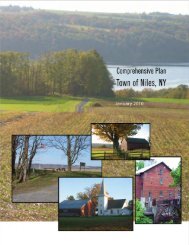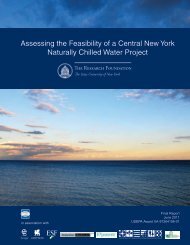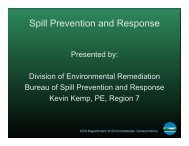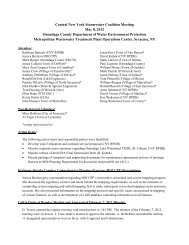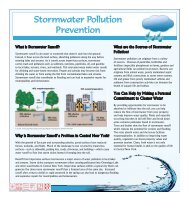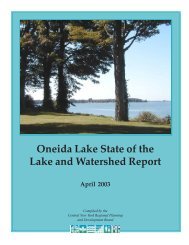A Management Strategy for Oneida Lake and its ... - CNY RPDB Home
A Management Strategy for Oneida Lake and its ... - CNY RPDB Home
A Management Strategy for Oneida Lake and its ... - CNY RPDB Home
Create successful ePaper yourself
Turn your PDF publications into a flip-book with our unique Google optimized e-Paper software.
<strong>Oneida</strong> <strong>Lake</strong> water levels are lowered after<br />
the navigation season to provide storage <strong>for</strong><br />
spring snowmelt <strong>and</strong> storm runoff. This is<br />
accomplished by fully opening each of the<br />
seven water control gates that create the<br />
Caughdenoy Dam near the beginning of<br />
December each year. These gates remain<br />
open throughout of the winter <strong>and</strong> the<br />
observed lake levels are a function of<br />
precipitation <strong>and</strong> runoff. Given the uncertainty<br />
of the timing of spring rain <strong>and</strong><br />
snowmelt, lake levels at times can rise above<br />
flood levels even with the Caughdenoy dam<br />
fully open. In the summer, levels are<br />
regulated to provide reserve capacity<br />
sufficient to contain moderate runoff.<br />
NYS DEC Regulated<br />
Environmental Activities<br />
Under the Federal Clean Water Act a permit is<br />
required to discharge point-source pollutants<br />
into waters of the United States. In New York<br />
State, the NYS DEC is the permitting authority<br />
of the State Pollutant Discharge Elimination<br />
System (SPDES) program. The program<br />
requires a permit <strong>for</strong> point-source discharges of<br />
wastewater into surface or ground waters of<br />
New York State; construction or operation of a<br />
disposal system, such as a sewage treatment<br />
plant; discharge of stormwater associated with<br />
industrial activity, including construction<br />
activities disturbing one or more acres; <strong>and</strong><br />
discharge of ballast from ships. Under the<br />
SPDES program, 157 facilities are permitted to<br />
discharge to the <strong>Oneida</strong> <strong>Lake</strong> watershed. This<br />
list includes solid waste facilities, inactive<br />
hazardous waste sites, underground <strong>and</strong> aboveground<br />
storage tanks, hazardous spills, mines,<br />
<strong>and</strong> oil <strong>and</strong> gas wells.<br />
Institutional <strong>and</strong> Regulatory Influences<br />
Federal<br />
The United States Environmental Protection<br />
Agency (US EPA) was created in 1970 in<br />
response to the growing public dem<strong>and</strong> <strong>for</strong><br />
cleaner water, air <strong>and</strong> l<strong>and</strong>. More than a<br />
dozen major statutes or laws <strong>for</strong>m the legal<br />
basis <strong>for</strong> the programs of the US EPA. In<br />
1972, the Clean Water Act (CWA) was<br />
passed <strong>and</strong> signaled the creation of a centralized<br />
federal legislation to protect <strong>and</strong> restore<br />
the biological, chemical, <strong>and</strong> physical<br />
properties of the nation’s water. The act<br />
was amended in 1977 <strong>and</strong> again in 1987,<br />
shifting focus to non-point sources of<br />
pollution, as well as point sources. Under<br />
the CWA, the stormwater program requires<br />
the implementation of programs <strong>and</strong> practices<br />
to control polluted stormwater runoff<br />
from urban areas <strong>and</strong> construction sites. Section<br />
404 of the Clean Water Act establishes a<br />
program to regulate the discharge of dredged<br />
<strong>and</strong> fill material into waters of the U.S., including<br />
wetl<strong>and</strong>s. Other important federal programs<br />
include the National Flood Insurance Program,<br />
the Safe Drinking Water Act, <strong>and</strong> the Farm Bill.<br />
State<br />
There are numerous other regulations <strong>and</strong><br />
programs that also influence l<strong>and</strong> use activities<br />
in the <strong>Oneida</strong> <strong>Lake</strong> watershed. Some of these<br />
are adopted <strong>and</strong> applied on a statewide basis.<br />
Regulations <strong>and</strong> programs administered by the<br />
NYS Department of Environmental Conservation,<br />
NYS Department of Agriculture <strong>and</strong><br />
Markets, <strong>and</strong> the NYS Department of Health<br />
uni<strong>for</strong>mly apply to all municipalities within the<br />
page 24<br />
Chapter 2: <strong>Oneida</strong> <strong>Lake</strong> <strong>and</strong> Its Watershed



